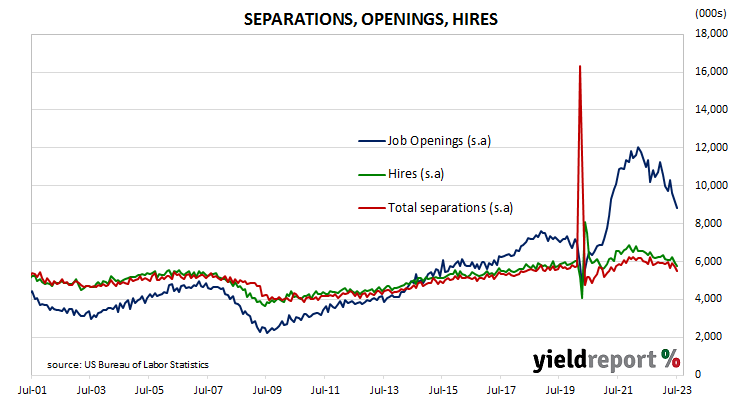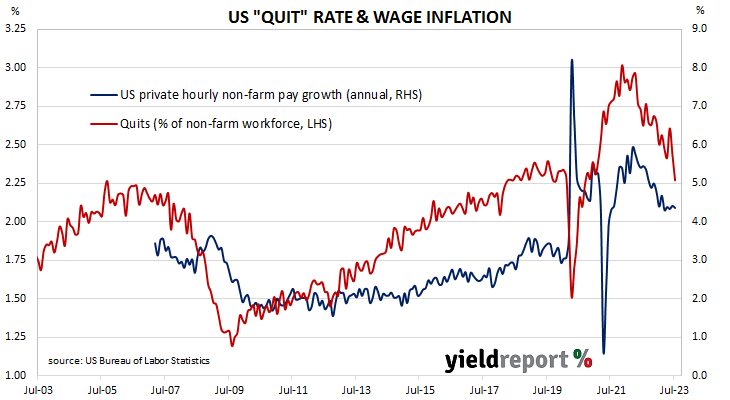Summary: US quit rate steady at 2.3% in August; NAB: consistent with less confidence; long-term US Treasury yields rise materially; expectations of Fed rate cuts in 2024 soften slightly; ANZ: opening numbers still high compared to historic numbers; quits, separations, openings all higher.
The number of US employees who quit their jobs as a percentage of total employment increased slowly but steadily after the GFC. It peaked in March 2019 and then tracked sideways until virus containment measures were introduced in March 2020. The quit rate then plummeted as alternative employment opportunities rapidly dried up. Following the easing of US pandemic restrictions, it proceeded to recover back to its pre-pandemic rate in the third quarter of 2020 and trended higher through 2021 before easing through 2022 and the first half of 2023.
Figures released as part of the latest Job Openings and Labor Turnover Survey (JOLTS) report show the quit rate remained steady in August. 2.3% of the non-farm workforce left their jobs voluntarily, unchanged from July. Quits in the month rose by 19,000 while an additional 187,000 people were employed in non-farm sectors.
NAB senior FX strategist Rodrigo Catril noted the steady quit rate, saying it matched ”the lowest level since 2020, consistent with workers remaining less confident in their ability to find another job in the current market, and suggesting some evidence of skill mismatch.”
Long-term US Treasury yields finished the day materially higher. By the close of business, the 2-year Treasury bond yields had added 4bps to 5.15%, the 10-year yield had gained 12bps to 4.80% while the 30-year yield finished 14bps higher at 4.93%.
In terms of US Fed policy, expectations of a lower federal funds rate in the next 12 months softened a touch. At the close of business, contracts implied the effective federal funds rate would average 5.405% in November, 8bps more than the current spot rate, 5.44% in December and 5.465% in January. September 2024 contracts implied 5.085%, 24bps less than the current rate.
The rise in total quits was led by 88,000 more resignations in the “Accommodation and food services” sector while the “Retail trade” sector experienced the largest loss, falling by 52,000. Overall, the total number of quits for the month rose from July’s revised figure of 3.619 million to 3.638 million.
Total vacancies at the end of August jumped by 690,000, or 7.7%, from July’s revised figure of 8.920 million to 9.610 million. The rise was driven by a 509,000 gain in the “Professional and business services” sector while the “Accommodation and food services” sector experienced the single largest decline, falling by 55,000. Overall, 11 out of 18 sectors experienced more job openings than in the previous month.
“Job opening numbers are still high compared to historic numbers,” said ANZ senior economist Adelaide Timbrell. “Further progress on bringing supply and demand back to greater balance is required but it is gradually trending in the right direction.”
Total separations increased by 38,000, or 0.7%, from July’s revised figure of 5.638 million to 5.676 million. The increase was led by the “Accommodation and food services” sector where there were 105,000 more separations than in July. Separations increased in 10 of the 18 sectors.

The “quit” rate time series produced by the JOLTS report is a leading indicator of US hourly pay. As wages account for around 55% of a product’s or service’s price in the US, wage inflation and overall inflation rates tend to be closely related. Former Federal Reserve chief and current Treasury Secretary Janet Yellen was known to pay close attention to it.


